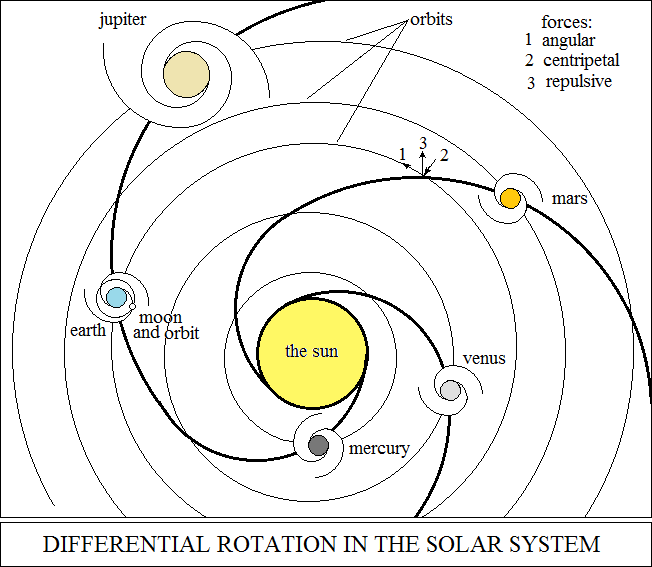-
Differential rotation
of vector structures.
The differential rotation of vector structures can be interpreted as a
phenomenon of the vector space, or as a phenomenon of the structure
of macroscopic bodies. The cause of the differential rotation cannot be
the
structure of the macroscopic bodies, the bodies themselves being structures
of the vector space. The differential rotation of the stellar and planetary
structures began with the formation of orthogonal (electromagnetic) circuits,
from the energy of the vector space. Therefore, the structure of orthogonal
circuits and the speed of rotation are interdependent. The speed of rotation
increases exponentially towards the center of the star, simultaneously
with the
increase in the density of vector circuits, of pressure (electromagnetic),
energy.
Observing the movement with differential rotation at the macroscopic level,
the question arises, if not, the vector space also endows the microscopic
structures, the hydrogen atoms, with differential rotation movement.
The idea already exists, in Rutherford's planetary atomic model, not as
a
differential rotation movement, but as a copy of the solar system.
This interpretation is not possible, due to the different orthogonal circuit
structures.
The macroscopic orthogonal circuits are asymmetric, one of the circuits
being
totally surrounded by the other circuit. The microscopic orthogonal circuits
of the hydrogen atom are symmetrical, with constant energy, passing
-
alternatively from one circuit to another,
generating a specific spectrum of
frequencies. Asymmetric macroscopic structures are cumulative, their centripetal
forces continuously compressing substances (microscopic structures).
In this way the luminous sphere is formed, the energy of the macroscopic
structures amplifies, they take different dimensions and the substance
is
decomposed vectorially, embedded in the energy of the orthogonal circuits,
in the electric nucleus. In the stellar structures, the vector space orients
circuits in three perpendicular directions, electric east west, magnetic
north south
and radial, bottom up. The electric and magnetic circuits move centripetal,
generating the radial orientation of the REP polarities and together,
the differential rotation. The differential rotation movement is revealed
by the orbital movements in the galactic, planetary and satellite systems.
The activity of a massive star reproduces the stars of a galactic system,
galactic stars reproduce star systems, planets and planets reproduce satellites.
Each macroscopic structure is differentially rotated around the mother
structure.
Movements in the universe are only differential rotations. The electromagnetic
rotation movement is produced by closed vecorial circuits, because there
was an Oersted, an Ampere, a Faraday and many others. The differential
rotation movement, however, is produced by "electrostatic" open
vector circuits,
-
which prove to be universally dynamic.
In the drawing, the differential
rotation shows a repulsive component of objects driven into rotation,
increasing towards the apogee, resulting in the expansion of the universe.

